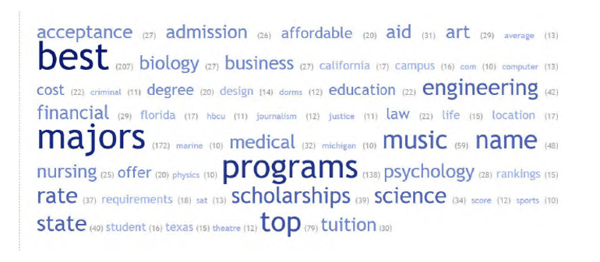Sure, you’ve done the homework. Maybe you’ve even hired a content strategist or SEO specialist. You get your monthly Google Analytics reports. You know this is what you should be doing, but is it effective? Is it doing anything?
Moving the SEO needle can be a complicated, technical, and long-term art form. Yes, I said art form. While we take the time to skim and scrape bounce rates and entrance percentages, behind any good SEO strategy is a thoughtful, creative vision, that delivers the heart of your brand and messaging in simple, digestible, and tactical ways. While the word optimization smacks of data and digital services and sends images of matrix-like code streaming down a screen, it is actually an exercise in clever and concise writing.
SEO Writing the Right Way
The basic rule of SEO writing is to consider target audiences, what they are looking for, and how they are looking for it. According to the 2019 E-Expectations Survey from our friends at OmniUpdate, prospective students search for particular majors and they use superlatives. A key takeaway is that 84% said they use non-branded search terms. In other words, they aren’t looking for specific institutions, they're looking for specific areas of study, lifestyle factors, and outcomes.

Behind any good SEO strategy is a thoughtful, creative vision that delivers the heart of your brand.
There's no need to get overly complicated. Prospective students aren’t searching for “Modern Perspectives in Humanitarian Engineering.” For higher ed marketing professionals tasked with SEO writing, these takeaways should feel liberating. Instead of getting hung up on keyword optimization, fitting into the exact right word count, and filling your content with jargon, focus on creating relevant, valuable content (and optimizing existing content!) that answers the questions your target audiences are asking.
This is where people often miss the forest for the proverbial trees: they're so focused on the "rules" of SEO that they don't even realize they've ended up with a piece of content no one actually wants to read. Keep it simple, relevant, and valuable, and those keywords and H1 and H2 headlines virtually write themselves.
Learn more about our work optimizing on-site search, UX, and SEO for Gen Z audiences with Illinois College.
 Top Search Terms According to E-Expectations Survey
Top Search Terms According to E-Expectations Survey
Pursuing a simplified form of writing will allow you, as an institution, to raise awareness and visibility of your high-ranking programs that might not pull on a normal search. Like our hypothetical “Modern Perspectives in Humanitarian Engineering,” we can break it down with headings and key phrases like “High Ranking Engineering Program” or “Engineering and Helping People” when it might have otherwise been buried. With this thinking, you can optimize your strong programs with low visibility by looking at the data with your Google Analytics or a service like Moz.
Don’t forget, search is reaching beyond google with all of the voice enabled devices like Alexa and Siri. People are asking specific questions that you should be answering. 36% of those surveyed in the E-Expectations survey were using voice search!
Length. It does matter. It doesn’t matter.
According to SEM Rush’s State of Content Marketing 2019, content with 3000+ words sees up to 3x more traffic, 4x more shares and 3.5x more backlinks than articles of average length (901-1200 words). But don't miss the forest for the trees: Don’t create for creation’s sake. The reason long pieces achieve more traffic is because it's packed with (a lot of) relevant and useful information. If your site is full of short-form content consider condensing or revising pages into a more robust and informative piece.
Other SEM Takeaways
- Listicles get the most shares and traffic (up to 2x more than other types of blog posts), followed by guides and “how to” articles.
- Articles with long headlines (14+ words) get 2x more traffic, 2x more shares and 5x more backlinks than articles with short headlines (7-10 words).
- Articles with 5 lists per 500 words get up to 4x more traffic and up to 2x more shares than articles with no lists.
Ultimately, more relevant content means more engagement, more interaction, and more visibility.
Structured for Success
Setting up your structure on the backend will greatly assist you in streamlining your SEO practice. Be sure to audit your site and do it regularly. All too often, as part of the early phases of our client engagements, we discover .edu’s with thousands of content and metadata issues. These issues, like poorly structured titles, missing meta descriptions, and missing H1 headers, are small and easy fixes that with a little strategy and a quality writer are resolved quickly and can immediately boost your search rankings and visibility.
In other words, the more easily Google can crawl your site and understand the information on it, the better you’ll perform in search. According the same survey, 36% of articles with h2 and h3 have high performance in terms of traffic, shares, and backlinks which all boosts rank and visibility.
Edu and YouTube
We can’t forget the internet’s second largest search engine, YouTube. Gen Z is all over YouTube. According to the digital admissions survey conducted by mStoner and Target X, 55% of teens use it at least once a day. More importantly, 27% said that videos on YouTube were a major influence on where they enrolled. Let that sink-in for a second: more than 1 in 4 students cite it as a major influencer on where they enrolled for college!
So, what makes good YouTube content? Pulling back the curtain and really allowing prospective students to understand what life at your institution would be like. Authenticity is revered over Talking Points, every time. While the YouTube algorithm is a little more shrouded in mystery than Google’s, there a a few key practices to optimize your YouTube page that will help your videos rank, according to HubSpot and Backlinko.
- Optimize your descriptions. Put any CTA’s or important info in the first 100 characters, which is what displays on search.
- Insert your keyword in the video title
- Place subtitles and have accessible transcripts of your video. Not only does this help in ADA compliance, it increases search visibility & rankings.
- Be sure to tag and categorize your videos appropriately. Properly tagged videos allow you to populate in suggested videos, boosting your visibility.
Whether you’re an SEO veteran, a new hire trying to get started, or just trying to keep your .edu fresh and functional, follow these SEO writing best practices to move the needle on your ranking and better reach your target audiences in more meaningful ways.



